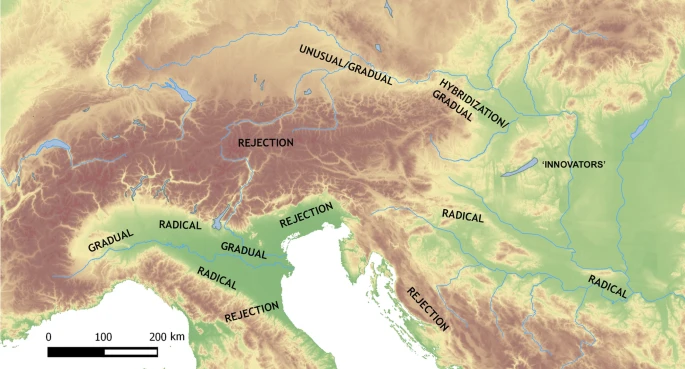Hawk
Regular Member
- Messages
- 2,281
- Reaction score
- 1,114
- Points
- 113
- Y-DNA haplogroup
- E-V13
Riverman, perhaps this can be of your interest.
Archaeological research is currently redefining how large-scale changes occurred in prehistoric times. In addition to the long-standing theoretical dichotomy between ‘cultural transmission’ and ‘demic diffusion’, many alternative models borrowed from sociology can be used to explain the spread of innovations. The emergence of urnfields in Middle and Late Bronze Age Europe is certainly one of these large-scale phenomena; its wide distribution has been traditionally emphasized by the use of the general term Urnenfelderkultur/zeit (starting around 1300 BC). Thanks to new evidence, we are now able to draw a more comprehensive picture, which shows a variety of regional responses to the introduction of the new funerary custom. The earliest ‘urnfields’ can be identified in central Hungary, among the tell communities of the late Nagyrév/Vatya Culture, around 2000 BC. From the nineteenth century BC onwards, the urnfield model is documented among communities in northeastern Serbia, south of the Iron Gates. During the subsequent collapse of the tell system, around 1500 BC, the urnfield model spread into some of the neighbouring regions. The adoption, however, appears more radical in the southern Po plain, as well as in the Sava/Drava/Lower Tisza plains, while in Lower Austria, Transdanubia and in the northern Po plain it seems more gradual and appears to have been subject to processes of syncretism/hybridization with traditional rites. Other areas seem to reject the novelty, at least until the latest phases of the Bronze Age. We argue that a possible explanation for these varied responses relates to the degree of interconnectedness and homophily among communities in the previous phases.
https://link.springer.com/article/10.1007/s10963-022-09164-0
The earliest examples of urnfields in the area under consideration can be found in the Carpathian Basin, where this new and complex way of treating and disposing of the dead tends to be juxtaposed with and/or replace the traditional flat inhumations, primary cremations (‘in situ cremations’), or scattered cremations from at least the twenty-fifth century BC. However, it is during the first half of the 2nd millennium BC—and more intensively around the sixteenth–fifteenth centuries BC—that the urnfield custom crosses its original boundaries and starts to be intensively practised in other regions, or isolated sites still surrounded by communities practising other kinds of funerary ritual. To what extent the spread of the urnfield model is the result of cultural transmission rather than (at least partially) a demic diffusion can be debated, but unfortunately not easily verified, since cremation destroys DNA and therefore the identification of any population movement via aDNA analysis. Beside the ideological aspects, the new biomolecular evidence of virulent pathogens, most notably Yersinia pestis, found in individuals dated to the 3rd and 2nd millennia BC, from Central Asia to Central/Northern Europe (Andrades Valtueña et al., 2017; Rasmussen et al., 2015; Spyrou, 2018; Rascovan et al., 2019), suggests that the diffusion of certain epidemics, especially in densely populated and well-interconnected regions, might have triggered practical responses by societies attempting to limit transmission. The burning of corpses may be one of these.
What appears clear from the current archaeological evidence is that the neighbouring regions maintained a range of attitudes towards the exogenous innovation, spanning from radical acceptance to gradual introduction, or from hybridization to complete rejection (see also Falkenstein, 2012, p. 329; Rebay-Salisbury, 2012, p. 21).



